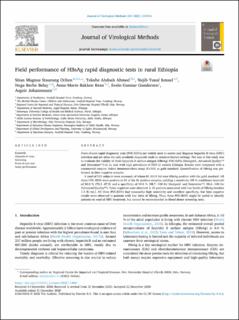| dc.contributor.author | Orlien, Stian | |
| dc.contributor.author | Ahmed, Tekabe Abdosh | |
| dc.contributor.author | Ismael, Nejib Yusuf | |
| dc.contributor.author | Belay, Nega Berhe | |
| dc.contributor.author | Kran, Anne-Marte Bakken | |
| dc.contributor.author | Gundersen, Svein Gunnar | |
| dc.contributor.author | Johannessen, Asgeir | |
| dc.date.accessioned | 2023-05-08T10:22:19Z | |
| dc.date.available | 2023-05-08T10:22:19Z | |
| dc.date.created | 2021-01-06T08:31:15Z | |
| dc.date.issued | 2020 | |
| dc.identifier.citation | Journal of Virological Methods. 2020, . | |
| dc.identifier.issn | 0166-0934 | |
| dc.identifier.uri | https://hdl.handle.net/11250/3066852 | |
| dc.description.abstract | Point-of-care rapid diagnostic tests (POC-RDTs) are widely used to screen and diagnose hepatitis B virus (HBV) infection and are often the only available diagnostic tools in resource-limited settings. The aim of this study was to evaluate the validity of three hepatitis B surface antigen (HBsAg) POC-RDTs (Healgen®, Advanced Quality™ and Determine™) in an area with high prevalence of HBV in eastern Ethiopia. Results were compared with a commercial enzyme linked immunosorbent assay (ELISA) as gold standard. Quantification of HBsAg was performed in false negative samples. A total of 511 subjects were screened, of whom 81 (15.9%) were HBsAg-positive with the gold standard. All three POC-RDTs were positive in 65 of the 81 positive samples, yielding a sensitivity (95% confidence interval) of 80.2% (70.3-87.5) and a specificity of 99.8% (98.7-100 for Healgen® and Determine™; 98.6-100 for Advanced Quality™). False negatives were observed in 16 patients associated with low levels of HBsAg (median 1.5 IU/mL). All three POC-RDTs had reasonably high sensitivity and excellent specificity, but false negative results were observed in patients with low titres of HBsAg. Thus, these POC-RDTs might be useful to identify patients in need of HBV treatment, but cannot be recommended as blood donor screening tests. | |
| dc.language.iso | eng | |
| dc.title | Field performance of HBsAg rapid diagnostic tests in rural Ethiopia | |
| dc.type | Peer reviewed | |
| dc.type | Journal article | |
| dc.description.version | publishedVersion | |
| dc.source.pagenumber | 17 | |
| dc.source.journal | Journal of Virological Methods | |
| dc.identifier.doi | 10.1016/j.jviromet.2020.114061 | |
| dc.identifier.cristin | 1866035 | |
| cristin.ispublished | true | |
| cristin.fulltext | original | |
| cristin.qualitycode | 1 | |
